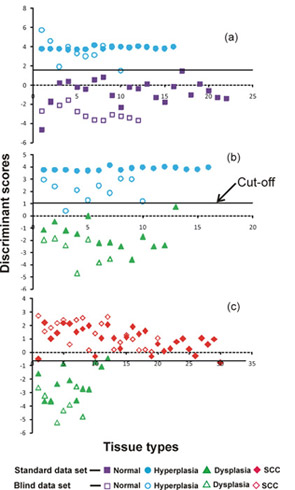According to the results of a clinical study published in the July 2011 issue of the British Medical Journal, strong proof-of-principle for utilization of diffuse reflectance spectroscopy (DRS) for early detection of oral cavity cancer has emerged. In India, oral cancer is the third most common cancer and constitutes 16.5% of all cancers with relatively high incidence rates of 21.5 and 12.8 per 1,00,000 men and women. These clinical trials were carried out at the Government Dental College, Trivandrum
in 96 patients with cancers affecting the buccal cavity and in 34 healthy volunteers (for comparison), using a fiber-optic point monitoring instrument developed at the Biophotonics Laboratory of CESS. On analysis of spectral data using statistical techniques such as PCA, LDA and LOO methods, it was observed that DRS efficiently discriminates healthy tissue from premalignant dysplastic lesions with 100% sensitivity and 95% specificity, thereby highlighting the potential use of this non-invasive technique for oral cancer screening in routine clinical practice. It is hoped that the ability to observe disease onset and progression through non-invasive and cost effective screening methods may help to implement the prevention and treatment strategies at an early stage. The public health implications of this technique are significant as it is easy to carry out in a variety of clinical settings and even easier to apply in the general public for population wide screening of early neoplastic changes in the oral cavity. Full details of this study can be downloaded from: Jayanthi JL., Nish GU, Manju S, Philip EK, Jeemon P, Baiju KV, Beena VT, and Subhash N, Diffuse reflectance spectroscopy: Diagnostic accuracy of a non-invasive screening technique for early detection of malignant changes in the oral cavity, BMJ Open July 2011 [doi:10.1136/bmjopen-2011-000071].
Discriminant function scatter plot of different lesion pairs. a) normal -hyperplasia b) hyperplasia – dysplasia and c) dysplasia – SCC. The solid symbols represent functions of standard data set and open symbols correspond to blind (validation) data set. The continuous line represents the cut-off value in each pair.




 RTI Act
RTI Act
